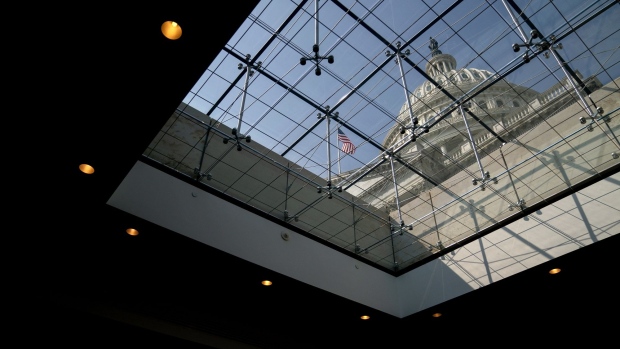Dec 7, 2021
House Passes Bill Opening Way to Quick Debt Ceiling Increase
, Bloomberg News

(Bloomberg) -- The House passed legislation Tuesday that would create a quick process to raise the U.S. debt ceiling by a simple majority vote in the Senate, approving a procedural measure on a 222 to 212 vote.
Under the terms of the bill, Democrats would receive one-time fast track authority to raise the U.S. debt ceiling, likely by an amount sufficient to cover borrowing through 2022.
The vote lessens the risk of a U.S. payment default this month. The bill would also cancel automatic cuts to Medicare, farm subsidies and other programs triggered by deficit spending earlier this year.
Earlier in the day Senate Majority Leader Chuck Schumer and Minority Leader Mitch McConnell announced they had reached an agreement to facilitate a debt ceiling increase.
Once the bill that just cleared the House is passed by the Senate, Democrats will be permitted for one time only to add a yet-to-be-determined amount to the U.S. debt ceiling without the threat of a Republican filibuster blocking the action. After Senate passage, the House would then take up the bill, Speaker Nancy Pelosi said.
“Democrats always said that we were willing to shoulder the load at 50 votes to get this done as long as it wasn’t in a convoluted or risky process, and Leader McConnell and I have achieved that,” Schumer said.
McConnell and his top lieutenants argued that the deal forces Democrats alone to cast the vote to raise the debt ceiling, allowing the GOP to argue in the upcoming 2022 elections that Democrats had added trillion in debt.
“I think this is in the best interests of the country,” McConnell told reporters at the Capitol, adding that it also was in “in the best interests of Republicans.”
Nonetheless, House Republicans opposed the bill over the debt ceiling provisions that McConnell negotiated, calling it a “poison pill.”
“Make no mistake this debt ceiling is being lifted to pay for trillions in wasteful socialist spending,” Texas Republican Kevin Brady said.
Democrats have argued that the limit increase is necessary after years of deficit spending approved by both parities and that their proposed $2 trillion tax and spending measure before the Senate is nearly paid for.
Two-Step Procedure
The legislative maneuver for the debt ceiling involves a bit of procedural gimmickry. The bill setting up the debt limit process would need 10 Republican votes in the Senate to advance, but does not itself raise the debt limit. A second bill raising the ceiling then could be passed with just Democratic votes based on the rules changes in the first bill. Democrats have not yet specified how much they are planning to increase the ceiling by, but have discussed a roughly $2 trillion increase to extend borrowing through 2022.
McConnell and other GOP leaders expressed confidence they can muster 10 votes needed to pass the first procedural bill when it comes up for a Senate vote, likely on Thursday. Some Senate moderates said they were still on the fence about the move after a vigorous lunchtime party discussion, however, so McConnell may have some arm twisting to do. Tying the debt ceiling measure to provisions turning off Medicare cuts may help.
“A lot of people don’t want to cut, or be part of these cuts,” Missouri Republican Senator Roy Blunt said.
If all goes smoothly, the actual debt ceiling increase bill is expected to be enacted by the middle of next week. Under the terms of the deal, Democrats could raise the ceiling by such a large amount to effectively render it toothless, but so far they have not shown any willingness to do so.
“We’re going to try and move as quickly as possible,” Schumer said, and Democrats plan a debt limit increase that would leave them with “very comfortable breathing room.”
Deadline Approaching
Treasury Secretary Janet Yellen has warned that she cannot guarantee the U.S. can meet all its payment obligations after Dec. 15. The Bipartisan Policy Center think tank has estimated Treasury would run out of cash between Dec. 21 and Jan. 28, with extra time coming if Treasury delays a $118 billion transfer to the Highway Trust fund under the terms of President Joe Biden’s infrastructure act.
Congress added $480 billion to the U.S. debt ceiling in October after 11 Republicans allowed a bill making the increase to pass the Senate. McConnell at the time vowed this would be the last time Republicans came to the aid of Democrats on the debt ceiling matter.
Clearing the debt ceiling off the December calendar could boost chances of Democrats passing Biden’s $2 trillion climate and social safety net expansion this month.
“We are heartened to see the progress being made today and hope for quick consideration so we can focus on the president’s economic agenda,” White House press secretary Jen Psaki said.
Medicare Cuts
The bill also seeks to defuse another fiscal time bomb set in motion by deficit spending: 10% in mandatory cuts to Medicare payments under both the so-called Paygo law and the Budget Control Act set to go into effect on Jan. 1. The pending cuts have alarmed hospital and doctors groups that say Medicare fee-for-service payments could be reduced by $14.1 billion in 2022 unless there’s action to stop them.
Cuts would also affect trade adjustment assistance, which helps workers who have lost their jobs due to trade-related circumstances, and farm price supports. Congress has previously waived the Paygo rule and Medicare sequester under the Budget Control Act.
“Some programs would be eliminated if statutory Paygo is implemented. So, it’s not hard to see why Congress has always intervened and why we must do so again now,” House Budget Committee Chairman John Yarmuth said.
©2021 Bloomberg L.P.